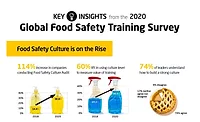Results of a New National Survey

While the U.S. food supply is considered generally safe, a steady stream of high-profile food-related illness outbreaks undermines that idea. Consumer confidence slides backward with each new episode of Escherichia coli, Salmonella and other health hazards splashed across the national news. Along with it goes the reputation of the suppliers who may or may not be responsible, ultimately, but who suffer the bruising reactions of an alarmed public.
Perceptions shaping reality? Yes. But the actual data on safety incidents are not exactly reassuring. It’s not a perception, for example, that the U.S. Food and Drug Administration (FDA) website shows recalls, market withdrawals and safety alerts for about 50 products (including animal food products) just in the month of August, 2010.[1] The U.S. Department of Agriculture (USDA) Food Safety and Inspection Service lists about 14 meat product recalls in the months between June and August of 2010,[2] illustrating that food safety has become an increasing concern not only for the end consumer but also for other stakeholders within the food industry.
Not surprisingly, the FDA, USDA and other government agencies are intensifying efforts to improve food surveillance, reporting and traceability within the supply chain and to reach consumers with timely food safety information. A number of food establishments within the food industry including retailers, distributors and foodservice providers are also now requesting that their suppliers meet specific food safety and quality standards in order to buy products from them. This has led to the development of stricter food safety standards, benchmarks and specifications. In turn, the field of third-party certification (i.e., product or process certification) is being recognized as one of the tools that can be applied to make the food supply safer in perception and in reality.
While not new, third-party certifications are gaining increasing favor as perhaps the best way to audit supplier practices and communicate the value of that process up and down the supply chain and, potentially, to consumers directly. The industry has wrestled over the years with the lack of symmetry in private auditing schemes and the inability of these programs to galvanize public confidence.
The combination of too many schemes and flagging consumer confidence is driving the industry to seek more harmony and simplification through standards-based third-party audits. The Global Food Safety Initiative is a prominent effort at just such unification, and it provides a solid platform for gaining broad private-public support. The question becomes “How well do the stakeholders in food safety really understand third-party certification?”
Moving Forward
With all of this as a backdrop—and with the health of our food supply at stake—we undertook a survey of consumers and food industry professionals to better understand how people respond to different signals of food safety, and how they view third-party certification. The study was conducted in 2010 by the Product Center for Agriculture and Natural Resources at Michigan State University and was funded by DNV (Det Norske Veritas USA, Inc.).
We felt the timing was right because there are few, if any, surveys that simultaneously probe supply chain professionals and consumers on the topic of third-party certification.
Overall, a quick glance over the current food safety literature indicates the existence of a wide range of food safety-related studies mainly focusing on the following thematic areas:
• Most studies are product-specific, and meat and produce appear to be the leading sectors.
• A good number of studies focus on consumers’ perception, demand and willingness to pay for products with some kind of sustainability and/or food safety-related attributes (e.g., traceability/origin, quality and labeling).
• There are very limited studies regarding perceptions and attitudes towards food safety certification.
• Very few studies within the food supply chain (manufacturers, distributors and retailers) focus on food safety-related knowledge and training. There are no known studies that specifically address food supplier attitudes and perceptions towards third-party certification, generally suggesting a lack of research regarding the U.S. consumer and food industry perception and attitudes towards food safety certification programs.
A Fresh Perspective
The purpose of the present study is to create and disseminate new knowledge and information related to food safety practices focusing on third-party certification. The study explores and examines supply chain (i.e., manufacturer, distributor, wholesaler and retailer) and end consumer perspectives and attitudes towards food safety and related certification programs.
Specific objectives included the following:
• Explore consumer and food supplier (i.e., manufacturers, distributors, wholesalers and retailers) concerns, attitudes and perceptions about food safety.
• Assess consumer and food supplier perspective on food safety information sources and stakeholder roles.
• Examine consumer attitude towards food safety certification.
• Explore food safety certification practices and systems that are currently applied by food suppliers.
• Examine certification compliance costs and funding opportunities for third-party certification and related food safety programs.
The study was conducted in two phases. In the first phase, a web-based consumer survey was conducted to collect data from 404 randomly selected representative consumer households. The second phase focused on exploring food safety-related perceptions, practices and approaches within the supply chain, emphasizing operations of different food suppliers (i.e., food manufacturers, wholesalers, distributors and retailers). This was conducted in two steps.
First, an online survey was conducted to explore food safety issues and related certification practices of selected food suppliers. A total of 73 food suppliers (45 manufacturers and 28 distributors, wholesalers and retailers) responded to the survey. Fourteen of these food suppliers are very large companies with nine of them having annual sales of $1 billion or more. The suppliers represent a broad range of food and beverage sectors. Most represented sectors include bakery, meat, produce (fruits and vegetables) and beverages (alcoholic and non-alcoholic).
Second, a total of 16 food suppliers were contacted for follow-up interviews to get additional insights and perspectives on some key controversial and delicate issues identified from the surveys (e.g., food safety and branded products; funding source and resource allocation for third-party certification programs; promotion and advertising). Interviews were conducted with four food suppliers who responded to the request and represent medium and large companies. All interviewees are involved in food safety- and quality control-related activities within their companies. Their responses were thus relevant for the purposes of triangulation and getting deeper perspectives on the issues.
Key Findings
The following are some of the key findings from the study related to food safety and third-party certification.
Food safety and sustainability—general
• Consumers are highly knowledgeable about food safety. However, they perceive that they have limited ability to control the safety of food they are consuming on a daily basis.
• Consumers and food suppliers have concerns about the safety of food that comes through the supply chain. Food suppliers’ concerns tend to be higher.
• There is a high food safety concern in meat products and in products that are internationally sourced. Also, processed food appears to be riskier than non-processed food.
• Sanitation and prevention and control of contamination are the most important food safety issues of concern for both consumers and food suppliers. In addition, product source/traceability is a very important issue for food suppliers.
• Consumers and food suppliers have made significant changes in their food purchasing habits in the past
5 years because of food safety related issues.
Consumers provided highest priority to ingredients and nutrient content of products. Brands of products were considered as the second most important attributes. Also, product certification and traceability received moderate importance.
Food suppliers provided the highest priority to product source/traceability. Ingredient/nutrient content and product certification were viewed as the second most important attributes in making purchase decisions.
• Both consumers and food suppliers view food producers and manufacturers as the lead supply chain actors to assure and guarantee the supply of safe food.
• There is some divergence in perceptions on the trustworthiness of food safety information sources.
University researchers and educators are the most credible information sources for the consumer. Food certification groups and consumer organizations are viewed as the second most important sources of information.
The consumer has less trust for information that comes from supply chain actors and the media.
Food suppliers have the highest trust in their in-house food safety-related operations (e.g., their food safety and quality control staff). Their suppliers and university researchers/educators received the second highest trust. Moderate trust towards information from food certification groups.
• Consumers and food suppliers agree that a wide range of issues have a significant relevance in creating a sustainable food system. For both consumers and food suppliers, producing and supplying safer and healthier food products is seen as one of the most important issues.
Third-party certification
• Consumers and food suppliers have a high positive attitude towards certified food products. A majority believe that they are safer than their non-certified counterparts. However, food suppliers seem to be less confident than consumers.
• Consumers and food suppliers have some divergent perceptions on food safety attributes that convey food safety assurances.
Consumers believe that government inspection provides the highest food safety assurance. Third-party certification is considered the second most important attribute to assure the supply of safe food. Consumers perceive that brand name and premium price play limited roles in assuring food safety.
Food suppliers perceive product source/traceability as the most important attribute that assures the supply of safe food. They view brand name, third-party certification and government inspection as the second most important attributes. They agree with the consumers that premium price plays a limited role in assuring food safety.
• The consumer tends to differentiate between third-party certification programs and related promotional activities while purchasing food products.
A clear preference is given to products that come through the supply chain carrying labels. Promoting such products is also accepted.
A retailer’s reputation is another key factor for the consumer to purchase those system/process products that do not come with labels.
The consumer tends to have less respect for promotional activities that are not aligned with labels and/or a retailer’s reputation.
• Food suppliers believe that it is appropriate for the retailer to promote and advertise third-party certification programs. However, cost is seen as a key prohibitive factor. Primary reasons for promoting these programs include building consumer confidence and enhancing company and industry reputation. Expanding market potentials and gaining competitive advantages are viewed as the second most important reasons, but promotion tends to have little impact on advancing acceptance of internationally sourced food products.
• A majority of the consumers and food suppliers do not believe that the consumer is willing to pay a premium for certified food products.
Roughly one-third of the consumers are, however, willing to spend up to 30% more for foods that are certified and labeled. The consumer is also willing to pay for those system/process certification practices. This needs to be seen in connection with the consumer’s preference to buy such products from a supplier with a reputation in supplying safe food.
Similarly, a little more than a third of the food suppliers believe that the consumer is willing to pay a premium for certified food products but not higher than 20%.
• For food suppliers, (1) gaining consumer trust and reputation, (2) protecting consumers and (3) reducing risk and liability are the three top incentives to introduce and implement third-party certification programs. Regulatory compliance and market-related incentives are seen as the second most important incentives. Third-party certification’s role in creating international acceptance and reducing insurance costs is considered to be minimal.
• For food suppliers, cost is seen as a key prohibitive factor to comply with third-party certification.
• Cost and program implementation complexities are the most important factors food suppliers consider in choosing audit and certification agencies.
• Consumers and food suppliers have divergent views on funding priorities for food safety programs.
Consumers largely favor more funding and resource allocation for third-party certification in balance with government inspection and traceability.
Food suppliers favor funding for product source/traceability programs.
• With regard to funding for third-party certification programs, food suppliers believe that market forces should primarily drive certification. The private sector should take the lead in funding these programs. Industry and public support would be needed to bridge the funding gap and to minimize risk.
• Interviewed food suppliers suggested the need for strengthening the scientific basis of the existing and newly emerging certification standards to make them acceptable by a wide range of stakeholders and to meet regulatory requirements.
Overall, from the highest level, the key takeaways from the study are the following:
• Consumers and food suppliers have divergent views on prioritizing food safety programs for resource allocation purposes, which appears to be complicated by the proliferation of different food safety standards and benchmarks.
• Food suppliers are introducing third-party certification schemes primarily as a risk management tool, mainly to reduce risks associated with liability claims.
• Throughout the surveys, traceability has been favored among suppliers, while consumers favored third-party
certification.
This divergence likely goes back to the foundations of trust.
For the consumer, an independent third-party certification adds a level of credibility.
This also suggests that the different forms of food safety programs would continue to co-exist.
Over time, university-government-industry collaboration would play a critical role in developing and implementing sustainable and more unified certification standards that are acceptable to and applicable for a variety of stakeholders. This would also help reduce compliance costs for food suppliers.
Christopher Peterson, Ph.D., is the director of the Michigan State University Product Center for Agriculture and Natural Resources, which focuses on assisting agricultural, food, natural resource and bioeconomy firms in the development of new markets, products and associated supply chain relationships. He received a Ph.D. in Agricultural Economics from Cornell University and an MBA from the Harvard University Graduate School of Business.
References
1. www.fda.gov/Safety/Recalls/ArchiveRecalls/2010/default.htm?fragment25_NextRow=1.
2. www.fsis.usda.gov/Fsis_Recalls/Open_Federal_Cases/index.asp?src_location=Content&src_page=FSISRecalls.
Looking for quick answers on food safety topics?
Try Ask FSM, our new smart AI search tool.
Ask FSM →








